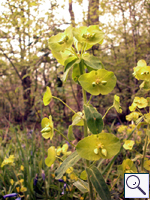|
||||||
|
EUPHORBIA. Spurges. [Euphorbiaceae] |
|
|
Thirty-three species of Euphorbia are recorded in Britain, twelve of which are native. The BSBI provide a downloadable plant crib for Euphorbia. Three British miners are recorded on Euphorbia. A key to the European miners recorded on Euphorbia is provided in Bladmineerders van Europa. |
 Wood Spurge Euphorbia amydaloides |
Key for the identification of the known mines of British |
||
1a > Leaf-miner: A conspicuous blotch, with characteristic greenish diffused frass, several larvae frequently feeding together (Spencer, 1972b: 54). Primary upper-surface blotch without a trace of a preceding corridor, generally containing several larvae. The mine contains much greenish and half-deliquescent frass. Pupation outside the mine. Forms an upper surface blotch mine. The mine can contain several larvae. |
||
|
||
Liriomyza pascuum (Meigen, 1838) [Diptera: Agromyzidae]. |
||
1b > Leaf-miner: A distinctive mine primarily above mid-rib, with irregular short lateral offshoots into leaf blade. Pupation external (Spencer, 1972: 51 (fig. 172), 55; Spencer, 1976: 270, 271 (fig. 486)). Branched, whitish, upper-surface corridor; main axis overlying the midrib; side branches overlying the main lateral veins. (In Campanula and Phyteuma the mine is much less branched, sometimes nothing more than a corridor on top of the midrib). Frass in rather long strings. Usually the mines begins as a long and narrow, shallow, tortuous lower-surface corridor that ends upon the midrib but otherwise is not associated with the leaf venation. Often this initial corridor is filled with callus, and then even less conspicuous. Pupation outside the mine. A linear mine on the upper surface, usually following the midrib and showing side branches along the veins. The frass is in strings. |
||
|
||
|
||
Liriomyza strigata (Meigen, 1830) [Diptera: Agromyzidae]. |
||
1c > Leaf-miner: In the first instar the larva mines the leaves, forming short, irregular, blotch-like mines, but in later instars it lives externally, feeding in spun leaves and often twisting those of tender shoots. Larval head light-brown or yellowish brown, edged with black postero-laterally, ocellar area blackish; prothoracic plate black edged with whitish anteriorly; abdomen dull dark green; pinacula distinct, black, sometimes brownish but with black bases to setae; anal plate large, black (Bradley et al., 1973). Small, full depth mine without a definite shape; little frass. Some silk is deposited in the mine. The larva soon leaves the mine and continues feeding among spun leaves. |
||
|
||
Cnephasia incertana (Treitschke, 1835) [Lepidoptera: Tortricidae]. |
||
| Last updated 09-Jul-2020 Brian Pitkin | ||

